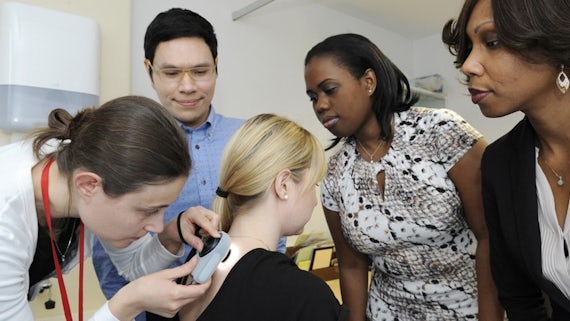Psoriasis Family Index
The Psoriasis Family Index (PFI-14) is a questionnaire designed for adult (aged 16 years or over) family members or partners of patients (of any age) with psoriasis.
About the questionnaire
The Psoriasis Family Index is self explanatory and can be simply handed to the patient’s family member or partner who is asked to fill it in without the need for detailed explanation.
The questions are designed to assess quality of life at the time of completion.
It is designed to be used alone or as an additional outcome measure in conjunction with any patient-completed questionnaire, such as the Dermatology Life Quality Index (DLQI).
Who can use it
This questionnaire can be used in a range of settings by clinicians, pharmaceutical companies, with-profit organisations, students or researchers.
Depending on who you are and what you're using the questionnaire for, you may need to apply for licence and pay a fee.
Learn more about who can use this questionnaire and how to administer it.
Time for completion
It is usually completed in two to three minutes.
Download the questionnaire
The PFI-14 is available in English, Italian and Polish.
Psoriasis Family Index (PFI) - English version
The Psoriasis Family Index (PFI-14) is a questionnaire designed for adult (aged 16 years or over) family members or partners of patients (of any age) with psoriasis.
If this document cannot be read by your assistive software, you can request an accessible version by emailing web@cardiff.ac.uk. Please include the assistive tools you use and the format you require.
Different language versions
This zip file contains the Italian and Polish versions of the questionnaire, along with the translation certificates. Find out more about our translation and linguistic validation process, and what to do if you'd like to create a new translation.
Psoriasis Family Index (PFI) - different language versions
This questionnaire, translated into Italian, Polish and Turkish, is for adult (more than 16 years of age) family members or partners of patients with psoriasis.
How to score it
The scoring of each question is:
- Not at all = 0
- A little = 1
- A lot = 2
- Very much = 3
- Question unanswered = 0
The Psoriasis Family Index total score is calculated by summing the score of each question resulting in a maximum of 42 and a minimum of 0.
The higher the score, the more quality of life is impaired. The Psoriasis Family Index can also be expressed as a percentage of the maximum possible score of 42.
Interpretation of incorrectly completed questionnaires
There is a high success rate of accurate completion of the Psoriasis Family Index. However, sometimes subjects do make mistakes. If one question is left unanswered, this is scored 0 and the scores are summed and expressed as usual out of a maximum of 42.
If two or more questions are left unanswered the questionnaire is not scored. If two or more response options are ticked, the response option with the highest score should be recorded.
If there is a response between two tick boxes, the lower of the two score options should be recorded.
Copyright
The Psoriasis Family Index is copyright worldwide, so you must not change the format, wording or design of the questionnaire.
The copyright statement, which must always be reprinted at the end of every copy of this questionnaire in whatever language, is:
© PFI-14. A.M. Eghlileb, A.Y. Finlay, M.S. Salek, M.K.A. Basra, March 2014
By agreement, the University now owns and administers all copyright matters relating to the PFI-14.
Original USA Library of Congress Registration
Registration number: TXu001299116
Registration date: 19 May 2006
Authors: Dr AM Eghlileb and Professor AY Finlay
Publications
Original publication
Eghlileb AM, Basra MKA, Finlay AY. The Psoriasis Family Index: preliminary results of validation of a quality of life instrument for family members of patients with psoriasis. Dermatology 2009; 219: 63-70
Original publication of PFI-14 (current version)
Basra MK, Zammitt AM, Kamudoni P, Eghlileb AM, Finlay AY, Salek MS. PFI-14: a Rasch analysis refinement of the Psoriasis Family Index. Dermatology 2015; 231 (1): 15-23.
Other key publication
Eghlileb AM, Davies EEG, Finlay AY. Psoriasis has a major secondary impact on the lives of psoriasis family members and partners. British Journal of Dermatology 2007; 156: 1245-1250.
Contact us
If you have any questions, or you have feedback on our web pages, please get in touch.
General queries and feedback
Dr. Faraz Ali
Dermatology Quality of Life Administrator
Financial, contractual or student enquiries
Joy Hayes
Licencing enquiries
Technology Transfer office
If you need to contact Professor Finlay
Professor Andrew Finlay
We offer a range of postgraduate dermatology courses, delivered both on site in Cardiff and online for distance-learning.

